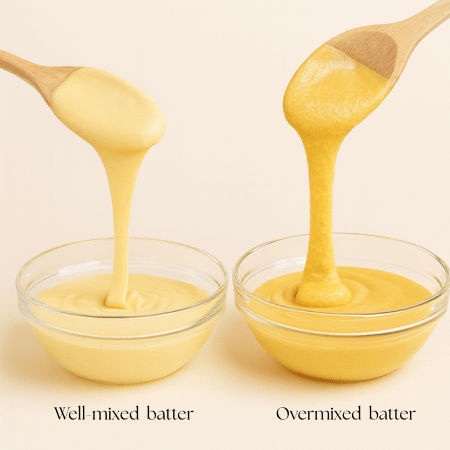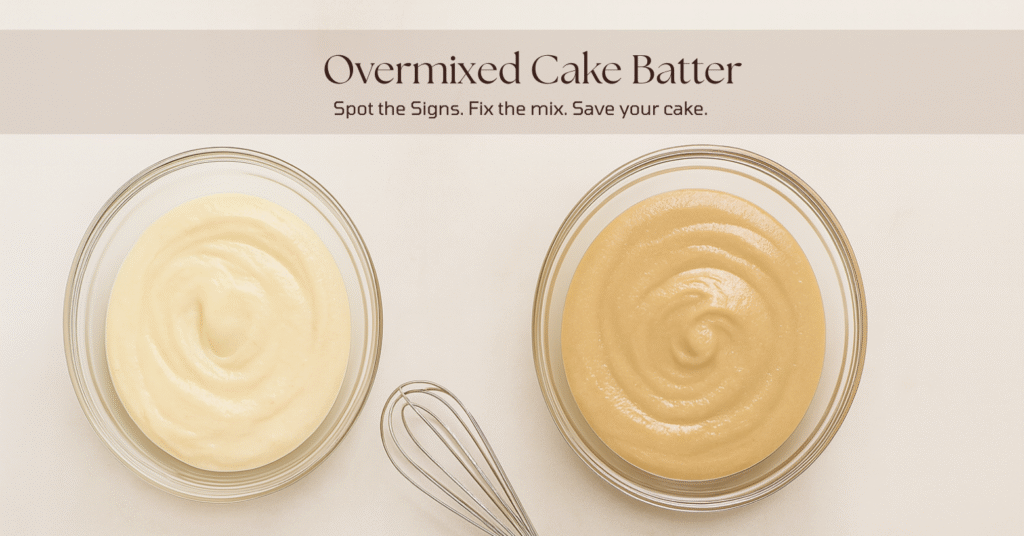Notice: I receive compensation if you buy something through affiliate links on this post. This does not change the price you would pay.
You’re watching your stand mixer whirl away, and you think, “Just a few more seconds to be safe”.
That’s often the exact moment you cross the invisible line into overmixed cake batter.
It happens to all of us.
Mixing is supposed to be the step that brings everything together, but too much of it can turn your light, tender cake into something dense and disappointing.
When I first started baking, I couldn’t count the number of times I overmixed my cake batter. I thought smooth and shiny meant “perfect.”
What I didn’t know was that my batter was quietly turning tough. It’s kind of like overwatering a plant you’re trying to help, but instead you’re suffocating it (I plead guilty to this, too).
The good news? Overmixing is easy to spot once you know the signs, and with a few simple habits, you can prevent it from happening again.
Contents
- 1 What Is Overmixed Cake Batter?
- 2 How a Properly Mixed Cake Batter Looks
- 3 How Do You Know If Cake Batter Is Overmixed?
- 4 What Really Happens When You Overmix Batter
- 5 Why Does Overmixing Make Cakes Dense or Gummy?
- 6 How to Prevent Overmixing in a Stand Mixer
- 7 How to Avoid Overmixing Altogether
- 8 How Do You Fix Overmixed Cake Batter?
- 9 Finding the Sweet Spot: When Cake Batter Is Just Right
- 10 Your Overmixed Cake Batter Questions, Answered
What Is Overmixed Cake Batter?
Overmixed cake batter is batter that’s been stirred or beaten past the point of just combining ingredients. It’s glossy, heavy, and stretchy in the bowl, and bakes into dense, gummy, or tough cakes instead of light and pillowy delights.
Can you overmix batter with a stand mixer?
When cake batter is mixed past the point of just combining ingredients, the texture becomes glossy, heavy, and stretchy, and when baked, it produces dense, rubbery cakes instead of soft, fluffy ones.
Can You Overmix Batter with a Stand Mixer?
Absolutely. Stand mixers are powerful. They can overdo the job in mere seconds. It’s a bit like driving a sports car: tap the pedal too hard, and you’re already going faster than you meant to.
How a Properly Mixed Cake Batter Looks
Before you can recognize overmixed, it helps to know what properly mixed looks like.
- The batter should be smooth and uniform in color, with no flour streaks hiding at the bottom.
- It feels slightly airy and light. Not runny. Not sticky.
- When you lift the paddle or whisk, the batter falls back into the bowl in ribbons that dissolve after a few seconds.
What does well-mixed cake batter look like?
It appears balanced, with a smooth, light texture and a slight fluffiness. Think of whipped cream at soft peaks: it holds its shape but still melts easily. Properly mixed cake batter lives in that same sweet spot.
How Do You Know If Cake Batter Is Overmixed?
So, what does trouble look like in the bowl?
5 Signs of Overmixing Cake Batter
- Batter looks glossy and thick, almost stretchy.
- Large bubbles pop and disappear quickly.
- Batter clings to the paddle like bread dough.
- Baked cake has tunnels or holes inside.
- Texture feels gummy, dense, or rubbery.
What does overmixed cake batter look like?
Overmixed batter is shiny, heavy, and lifeless. If properly mixed, batter is like a pillow; overmixed batter is more like a rubber band. It stretches, but it snaps back hard.
And it’s not just cakes:
- Overmixed macaron batter turns runny and spreads into flat shells.
- Overmixing pancake batter turns it into rubbery, flat pancakes.

What Really Happens When You Overmix Batter
Overmixing causes too much gluten formation and incorporates too much air in the batter
When you stir too hard or for too long, the gluten in flour forms long, tight strands. That’s great for bread, but not for cake; it makes the crumb tough and chewy instead of soft and delicate.
At the same time, overmixing traps extra air in the batter. Air helps the cake rise, but too much causes it to expand too quickly and then collapse in the oven, leaving a sunken, dense center.
It’s like trying to build a cloud with too much wind. It rises high, then falls apart.
For a deeper dive into gluten’s role in baking, check King Arthur Baking’s guide to gluten.
Why Does Overmixing Make Cakes Dense or Gummy?
If you’re using a stand mixer, overmixing happens not because you’re careless, but because your stand mixer is too efficient.
Common Causes
- High speed: Gluten develops faster when the mixer runs at full throttle.
- Mixing too long: Even an extra 30 seconds can push the batter over the edge.
- Wrong attachment: Whisks add too much air. The paddle is safer for most cakes.
- Delicate recipes: Sponge, chiffon, and angel food cakes are extra sensitive to overmixing.
How to Prevent Overmixing in a Stand Mixer
- Use low speed: You’re blending, not whipping.
- Scrape the bowl often: Flour hides in corners and at the bottom of the bowl. Don’t let it surprise you later.
- Watch for the ribbon stage: Lift the paddle. If the batter falls in ribbons that melt back in, it’s done.
- Follow recipe cues: “Fold gently” means stop using the mixer and grab a spatula.
👉 For help choosing the right speed, visit my Mixer Speed Guide.
How to Prevent Overmixing in a Stand Mixer
Here are some prevention tips to help you avoid overmixing your batter.
How long should you mix cake batter in a stand mixer?
Usually just until the flour streaks disappear. Around 1–2 minutes max at low speed.
What speed should you use to mix cake batter?
Low to medium. Think of it as blending, not whipping cream.
Other prevention tips:
- Scrape the bowl often so nothing hides at the bottom.
- Do the ribbon test: Lift the paddle. If batter falls in ribbons that blend back in, it’s ready.
- Respect recipe cues: “Fold gently” means use a spatula, not the mixer.
How to Avoid Overmixing Altogether
Remember this golden rule: stop mixing as soon as the batter looks even.
Here are a few easy ways to keep your batter in that perfect zone:
- Mix low and slow. Once both wet and dry ingredients are in the bowl, keep your mixer on low and stop as soon as the flour streaks disappear.
- Use a spatula for mix-ins. Fold in nuts, chocolate chips, or fruit by hand.
- Try a hand mixer. It’s gentler and gives you more control; you can feel when the texture is just right.
- Don’t fear small lumps. A few lumps mean your batter hasn’t been overworked. Perfectly smooth batter usually signals trouble.
- Watch the texture. It should look creamy and cohesive, not shiny or sticky.
👉 For more gentle mixing techniques, check Cookist’s baking tips.
How Do You Fix Overmixed Cake Batter?
Don’t despair if you end up with overmixed cake batter. You can still save it or use it to make other treats.
- Slightly overmixed? Loosen it with a spoonful of milk or yogurt and bake as cupcakes.
- Badly overmixed? Repurpose it into cake pops, trifles, or bread pudding.
Is overmixed cake batter still usable?
Yes. It won’t give you a fluffy cake, but it can still shine in other desserts. I once turned an overmixed birthday cake into a trifle layered with whipped cream and berries, and it was devoured in minutes.
Tips for Different Batters
- Cake batter: Gentle mixing keeps the crumb tender.
- Macaron batter: Folding is critical. Never use a mixer.
- Pancake batter: Lumps are good. Smooth usually means overmixed.
What happens if you overmix macaron batter?
It gets too thin and runny, resulting in fragile, hollow shells.
What happens if you overmix pancake batter?
It develops too much gluten, leaving pancakes flat and chewy.
👉 For more on mixing methods beyond cakes, check my guide to the 7 Mixing Techniques in Baking.
Finding the Sweet Spot: When Cake Batter Is Just Right
Every baker has brushed up against overmixing. It’s almost a rite of passage.
The trick is learning to spot when your batter has reached that sweet spot: smooth, light, and just airy enough to promise a tender crumb.
Overmixed cake batter, on the other hand, tips past balance. It turns glossy and heavy in the bowl, and bakes into cakes that feel more like rubber bands than pillows.
Once you see the difference, you’ll start trusting your instincts more than the timer.
And if you do go too far? Don’t worry. Even an “oops” can be turned into something sweet like cake pops, trifles, or a cozy bread pudding.
Baking isn’t just about perfection; it’s about practice, patience, and finding that rhythm where everything just comes together.
👉 If your stand mixer is giving you trouble beyond overmixing, you’ll find answers in my KitchenAid Mixer Troubleshooting Guide.

